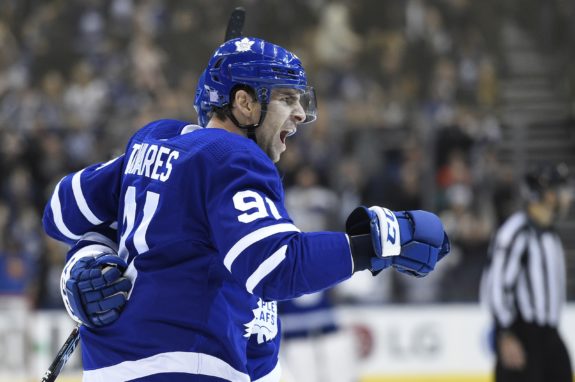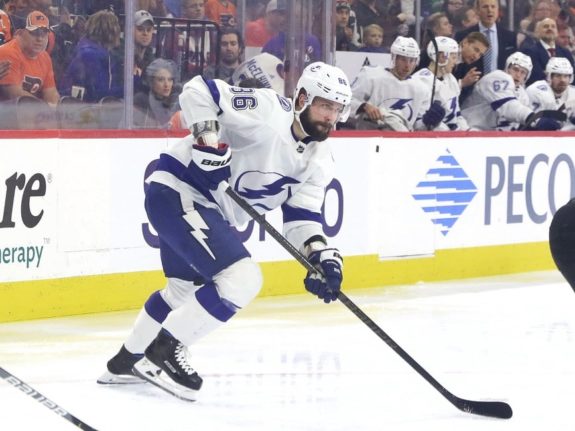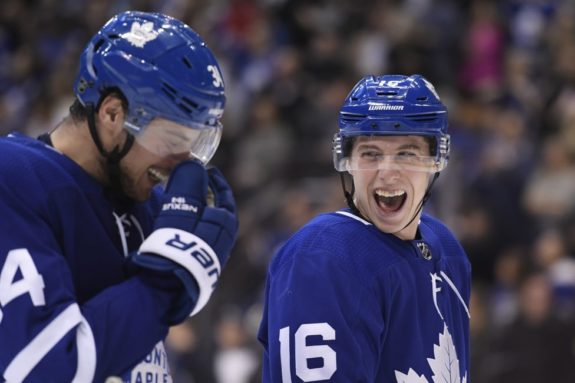When the Toronto Maple Leafs were ousted yet again during the 2020-21 playoff’s first round, there was anger and disappointment among Maple Leafs’ fans. Fingers first pointed at Mitch Marner for his poor playoff series. Trade him away was the call.
Related: Maple Leafs’ 2020-21 Season Saw a Mitch Marner Transformation
Some – although fewer – also pointed at Auston Matthews. A number of fans pointed to an iconic moment when he grinned as he was being shaken from behind, which some fans interpreted as fearful lack of willingness to respond physically. Fewer fans – but again some – pointed to Jack Campbell’s weak Game 7 goal.
Even William Nylander, the best player on the ice for the Maple Leafs, couldn’t escape the wrath of the disappointed fans. However, fans came at Nylander in a rather indirect way: trade the floating Swede while his value is high.

About the only member of what has become known as the Maple Leafs’ Core Four who escaped fans’ wrath was John Tavares, who suffered a horribly scary accident on the ice which had to have made his wife and any family who witnessed it physically shudder with fear.
The Biggest Complaint Just Keeps Coming Back
However, the biggest complaint we’ve read about the 2020-21 version of the Maple Leafs is like acid reflux. It just keeps coming back; and, it always leaves a bad taste in the mouth. It’s the complaint that the team’s top-heavy payroll structure doesn’t allow the franchise to ice a winning playoff roster. In fact, almost every critique of the Maple Leafs’ playoff failure ended with a phrase something like “This won’t be fixed until the Maple Leafs trade one of the Core Four.”
We Believe The Current Maple Leafs’ Salary Structure Can Work
In this post, once again long-time Maple Leafs’ fan Stan Smith and I will collaborate to suggest what has to happen for the organization to make the current salary structure work.
Jim’s Take on the Core Four
In truth, Stan and I were on different pages with our support for the salary invested in the Core Four as part of the team’s roster. I thought it unfortunate that salaries were so high and believed life would be easier if salaries were lower, but I believed in the logic of the signings.
Related: 7 Worst Trades in Boston Bruins History
First, Tavares, Nylander, Matthews, and Marner are all good players. Second, they’d constitute “the” core of the team moving into the future. Third, what seemed like a horrible contract when it was signed – Nylander specifically – would look more palatable as the salary cap rose. Fourth, the team would remain strong enough to compete for a playoff spot each postseason; once the playoffs started, who knew?

In fact, as soon as Jason Spezza signed on at NHL league minimum, I saw the Core Four as a benefit rather than a detriment. If the team were always strong, players such as Spezza and Joe Thornton would sign on as part of the possibility the Maple Leafs could make a run for it and they’d be part of that history.
Bad on me for not predicting a global pandemic that cancelled so many NHL games and removed so many fans in the stands.
Stan’s Take on the Core Four
For the longest time, Stan believed the idea of the Core Four couldn’t work and thought the Maple Leafs would have to break up Tavares, Nylander, Matthews, and Marner if they were to put together a balanced enough roster to compete for the Stanley Cup.
When he saw the moves that Maple Leafs’ general manager Kyle Dubas made last season, it made him think the idea could work. There were definite limitations and risks; but, if certain things happened, the organization could win with this “studs and duds” format.
Although the team failed to win last season, Stan came to believe the key idea itself wasn’t faulty. Instead, what needed to happen for them to win simply didn’t.
What Must Happen for the Core Four Concept to Succeed
We believe five things needed to happen for the Maple Leafs’ to win during the postseason, even with their salary structure.
Related: NWHL Roundup: Boston’s Big Roster Reveal
First, the best players needed to be their best players.
Second, Tavares, Nylander, Matthews, and Marner all needed to stay healthy.
Third, the Maple Leafs needed one or two players outside of Tavares, Nylander, Matthews, and Marner to have a good series.
Fourth, the rest of the lineup had to play the opposition evenly.
Fifth, the Maple Leafs needed decent goaltending.
What Happened During the 2021 Postseason
First, Nylander had a good playoff series. Marner and Matthews did not. Overall, the team’s best players were not their best players.

Second, Tavares was hurt and only played 2:53 of Game 1 before leaving the series for good. Additionally, their best all-around defenseman Jake Muzzin was hurt at a crucial time in Game 6.
Third, Alex Kerfoot stepped into Tavares’ spot and did a solid job, scoring a goal and adding five assists. He played a part in Nylander’s leading the team with five goals and three assists. Jason Spezza had a strong playoff series, finishing third in scoring on the team with three goals and two assists.
Fourth, the bottom of the lineup did not play the opposition evenly. Rasmus Sandin, Joe Thornton, Zach Bogosian, Pierre Engvall, Adam Brooks, and Travis Dermott were collectively -12 in plus/minus.
Fifth, Campbell was very good in goal, with the exception of the first goal in Game 7. To our eyes, he didn’t let in another soft goal.
Related: Toronto Maple Leafs Should Try to Sign Morgan Rielly Early
Of the five things that needed to happen, only two things (#3 and #5) actually happened.
What Can Be Learned from Last Postseason?
That leaves us with a key question: “Is there anything the Maple Leafs can do, aside from roster changes, to improve their chances of winning next season?”
We believe there is; and, we don’t believe it’s complex. During the 2019-20 postseason, head coach Sheldon Keefe – in his best effort to win the series – loaded up one line with his top players hoping that that line could pull off a victory. It couldn’t. In fact, stacking that single line had the reverse impact of rendering the other lines less effective offensively.
We believe Keefe made a similar call during the 2020-21 postseason; again, with similar results. With Tavares injured, he gave Matthews and Marner too much ice time and, by Game 7, they were completely gassed.
Time on Ice Must Be More Balanced
That leads to our main thesis. Time of play on the ice must be more balanced among the forward lines. To be specific, here’s the average ice time for each of the team’s top six forwards during the last two playoffs.
| Player | 2020 Postseason | 2021 Postseason |
| Marner | 24:39 | 24:43 |
| Matthews | 25 | 23:53 |
| Tavares | 22:42 | |
| Hyman | 20:57 | 22:51 |
| Nylander | 20:13 | 18:21 |
| Kapanen | 16:18 | |
| Kerfoot | 15:20 | 17:11 |
| Foligno | 14:11 | |
Over the two postseasons, Matthews averaged 24:26 and Marner 24:41. Comparing that to the Tampa Bay Lightning’s best two forwards over the last two playoffs, Nikita Kucherov averaged 21:40 TOI in 2020 and 18:18 in 2021. Braden Point averaged 20:32 TOI in 2020 and 18:55 in 2021.

Good defensemen can often “rest” on the ice. On any rush, one defenseman hangs back and he can use that time to catch his breath. It’s common for defensemen to play over a minute on a shift and common for top defensemen to play 25 minutes a game.
But, forwards can’t rest on the ice and must go full out for, ideally, about 30 to 40 seconds before they switch out. At first, Maple Leafs’ fans were happy new head coach Keefe gave Matthews more ice time than former head coach Mike Babcock did. But we think it’s gotten a bit excessive.
We tend to agree with NHL coaches who believe anything over 20 minutes for a forward is too much. Obviously, that call is contextual; and, during playoff games overtime games, give Matthews and Marner more ice time. However, averaging 25 minutes every game is too taxing and we believe makes it difficult for a forward to play at the top of his game.
Getting the Best Out of Maple Leafs’ Players
The Maple Leafs can get more out of their best players by targeting 20 minutes per game for all six players on the team’s top two lines and trusting all six of their top-six forwards equally – both during the regular season and the playoffs.
Related: Toronto Maple Leafs’ Nick Abruzzese: Small in Stature, Huge in Brain & Skill
Nylander played 18 minutes a game: he could have played more. A player like Kerfoot isn’t as elite as the Core Four, but still needs to play more than 16 minutes a game.
Sometimes Less Is More
If we look at the five things the Maple Leafs needed to do to win in the playoff series against the Montreal Canadiens, playing Matthews and Marner less would have helped them both stay fresher and perform better.

If the Core Four can remain healthy and rested, the bottom-six can play the opposition even, Campbell and/or Mzarek can play well enough, and one or two players outside of the Core Four can produce a really good playoff, the Maple Leafs can win as a playoff team.
[Note: Stan Smith’s Facebook profile is https://www.facebook.com/profile.php?id=687747632]